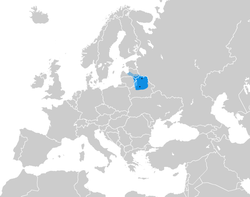Principality of Polotsk
| Principality of Polotsk | ||||||||
| Полацкае княства | ||||||||
| Vassal of Kievan Rus' to 1021 Part of the Grand Duchy of Lithuania since 1307 |
||||||||
|
||||||||
| Capital | Polotsk | |||||||
| Languages | Old East Slavic | |||||||
| Religion | Eastern Orthodox Church | |||||||
| Government | Principality | |||||||
| Prince of Polotsk | ||||||||
| • | 1044–1101 | Vseslav | ||||||
| Legislature | Veche | |||||||
| History | ||||||||
| • | Established | 987 | ||||||
| • | Incorporation into the Grand Duchy of Lithuania | 1397 | ||||||
|
||||||||
| Today part of | ||||||||
The Principality of Polotsk, also known as the Kingdom of Polotsk or the Duchy of Polotsk (Belarusian: По́лацкае кня́ства; Russian: По́лоцкое кня́жество), was a medieval principality of the Early East Slavs. The origin and date of state establishment is uncertain. The Russian chronicles mention Polotsk being conquered by Vladimir the Great, and thereafter it became associated with the Rurik dynasty and Kievan Rus'.
The Principality was supposedly established around the ancient town of Polotsk (modern Polatsk, Belarus) by the tribal union of Krivichs. In the second half of the 10th century Polotsk was governed by its own dynasty; its first ruler mentioned in the chronicles was the semi-legendary Rogvolod (?-978), better known as the father of Rogneda. The Principality was heavily involved in several succession crises of the 11th-12th centuries and a war with the Land of Novgorod. By the 13th century it was integrated into the Grand Duchy of Lithuania.
At the time of its greatest extent the principality stretched over large parts of today's northern and central Belarus and a smaller part of today's southeastern Latvia, including (besides Polotsk itself) the following towns: Vitebsk, Drutsk, Minsk, Izjaslaw (now Zaslawye), Lahojsk, Barysaw, Brachyslaw (now Braslaw), Kukeinos (now Koknese) and others.
...
Wikipedia


